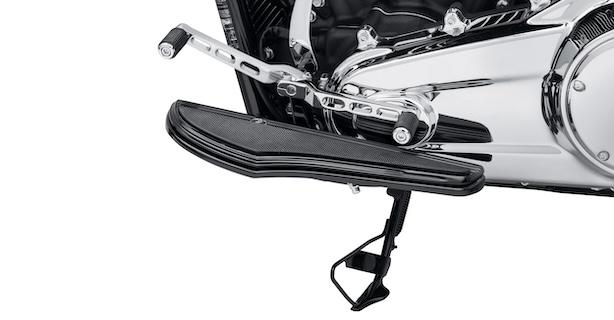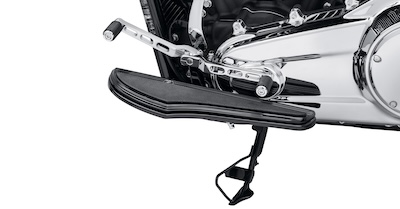Mastering the art of shifting gears is a fundamental skill that will elevate your motorcycle riding experience from merely moving to truly riding!
It's about syncing with your motorcycle's rhythm, understanding its language, and making every shift count towards a smooth, exhilarating ride.
This guide will explain the process, taking you step-by-step through the mechanics and timing of gear shifting so you can ride with confidence and precision.
MOTORCYCLE GEAR SHIFTING SYSTEMS
At the heart of every motorcycle is its gear-shifting system. This crucial component dictates how power from the engine is transferred to the rear wheels.
Most motorcycles feature a manual transmission with a sequential gearbox. Typically, this includes a five or six-speed gear shift pattern that is achieved by the coordinated use of a foot-operated gear shift lever and a hand-operated clutch lever control.
The standard shift layout from neutral finds first gear down, with the rest up in sequence: a simple "one down, rest up" pattern.
Be sure to familiarize yourself with your motorcycle's owner manual which typically provides a wealth of information about the motorcycle's gear shifting controls, operation, and specifications.
Understanding this system is the first step in mastering gear shifting, setting the foundation for effective control over your motorcycle's speed and acceleration.
WHEN TO SHIFT GEARS ON A MOTORCYCLE
Knowing when to shift gears is as important as knowing how.
It's about feeling the engine's power band, listening to its revs, and observing your speed. The goal is to keep the engine within its optimal performance range, whether you're accelerating, cruising, or slowing down.
READING YOUR BIKE'S TACHOMETER
Your motorcycle's tachometer is an invaluable tool, displaying the engine's revolutions per minute (RPM). It provides a visual indicator to aid you on determining when to shift up or down based on the RPM which helps ensure you're not over-revving or lugging the engine at your selected gear and road speed.
Refer to your motorcycle's owner manual for guidance on:
Recommended RPM Range
Redline RPM
Shift Points
Idle RPM
Engine Break-In Period
1. Starting The Motorcycle
Begin in neutral, then pull in the clutch lever fully with your left hand to disengage clutch and use your left foot to shift into first gear by firmly pressing the gear shift lever down then releasing. Slowly release the clutch lever to steadily increase engagement while gently applying the throttle. This initial gear engagement into first gear is crucial for a smooth start.
2. Upshifting While Riding
As you accelerate and the RPM climbs, prepare to shift up. Close the throttle, disengage the clutch, and nudge the gear lever up to the next gear. Smoothly release the clutch and gradually open the throttle again. Aim to upshift before the engine strains or revs too high.
3. Downshifting While Riding
When slowing down, downshift to match your speed and engine RPM. Close the throttle, pull in the clutch, and press the gear shift lever down to select a lower gear. Release the clutch gently and apply a bit of throttle to avoid abrupt speed reduction or engine braking.
4. Shifting In A Turn
It's generally best to complete gear changes before entering a turn. However, if you’re more experienced and must shift while turning, do so coordinating the controls smoothly. Avoid an abrupt clutch release or throttle changes that could upset the bike's balance.
5. Coming To A Complete Stop
As you approach a stop, roll off the throttle, pull in the clutch lever, and downshift sequentially to first gear. This ensures you're ready to start again without needing to cycle through gears while stationary. Disengage the clutch by pulling the lever fully as you come to a halt to prevent stalling.
6. Starting On A Hill
Starting on an incline requires balancing the throttle, clutch, and rear brake to prevent rolling backward. Engage the clutch to the point of the clutch plates "biting," or “friction zone” and apply enough throttle for the incline, and gradually release the rear brake as you move forward.
GEAR SHIFTING INSTRUCTIONS
Shifting gears on a motorcycle smoothly is a skill that marries the motorcycle's mechanics with the rider's intuition–and, eventually, muscle memory. It's about timing, precision, and understanding the symbiotic relationship between the engine's power and the motorcycle's motion.
We’ll walk you through the fundamental steps of gear shifting below.
Step 1: Close The Throttle
Begin by easing off or rolling off the throttle to reduce engine power. This initial step is crucial as it prepares the motorcycle for a smooth transition between gears by lowering the RPMs, ensuring the engine and gearbox are in a less stressed state before you disengage the clutch.
Step 2: Disengage The Clutch
With the throttle closed, squeeze the clutch lever fully to disengage the clutch and disconnect the engine from the transmission. This action temporarily interrupts power flow to the rear wheel, allowing you to shift gears without damaging the transmission.
Step 3: Shifting The Gears
Now, it's time to shift. Use your left foot to press down on the gear shift lever to shift down one gear or lift up to shift up to the next gear. If the clutch is fully disengaged, the gear should engage smoothly. Remember, the gear pattern is typically one down (first gear) gear pattern and then up for the rest (second, third, and so forth).
Step 4: Releasing The Clutch
After selecting your new gear, gradually release the clutch lever. This should be done smoothly to avoid a sudden jolt or loss of control. As you release the clutch, gently roll the throttle back on to match the engine speed to your new gear and maintain a smooth acceleration.
Step 5: Repeating The Process
As you continue to ride, and the need arises to change gears again–whether to accelerate further or to decelerate–repeat the process. Each transition between closing the throttle, disengaging the clutch, shifting gears, and then smoothly releasing the clutch and opening the throttle should become more intuitive over time.
WHAT IS A MOTORCYCLE GEAR SHIFT PATTERN?
Each gear in a motorcycle's shift pattern serves a specific purpose, from starting off to cruising at high speeds. Familiarizing yourself with this pattern and understanding the role of each gear will enhance your riding experience, ensuring you're always in the right gear for the speed, road conditions, and performance you desire.
So, let's break down the typical motorcycle gear shift pattern and explore the role of each gear.
First Gear: Getting Started
First gear is your starting point, designed for initial acceleration from a standstill. It provides the most torque and least speed, ideal for overcoming inertia. Engage first gear by pressing the shift lever down from neutral. Due to its higher torque, first gear is typically used for starting off or slow speed maneuvering and is quickly shifted out of once you're moving.
Second Gear: Proper Riding Begins
Once you're rolling, shifting up to second gear offers a balance between acceleration and speed, also makes it suitable for low-speed maneuvers and tighter control in traffic or residential areas.
Third Gear: Flexibility In Speed
Third gear introduces more flexibility, allowing for moderate acceleration and cruising speeds. It's versatile, making it ideal for city riding where speed varies. In third gear, the motorcycle starts to feel more agile, capable of efficient passing maneuvers.
Fourth Gear: Finding A Groove
Shifting into fourth gear, you'll find a comfortable middle ground for cruising. It's perfect for maintaining steady speeds with lower RPMs and improving fuel efficiency. Fourth gear is often used for rural roads and light highway travel, where speed is consistent but not at the maximum.
Fifth And Sixth Gears: High-Speed Riding
Fifth and, on some motorcycles, sixth gear are designed for high-speed riding and highway use. These gears lower the engine's RPM at high speeds, optimizing fuel consumption and minimizing vibration for a smoother ride. They are best utilized when you're at a significant fraction of your bike's top speed, offering a relaxed cruising experience.
WHAT ARE COMMON SHIFTING SOUNDS?
Recognizing the sounds associated with proper and improper gear shifting can help you understand whether you're shifting correctly and avoid potential issues with your motorcycle.
Here are some common shifting sounds and what they typically indicate:
1. Smooth Click Or Clunk (Proper Shifting):
Sound: A smooth, solid click or clunk when you shift gears.
Indicates: This sound generally indicates that the gear has engaged properly. It's normal to hear a distinct sound as the gear plates mesh together during a shift.
2. Engine Revving (Shift At The Wrong Time):
Sound: The engine revs up or becomes louder without an increase in road speed.
Indicates: This may occur if you shift too late (over-revving) or if you miss a gear. Ensure you're shifting within the correct RPM range to avoid unnecessary engine strain.
3. Grinding Or Harsh Clunk (Improper Shifting):
Sound: A grinding noise or a harsh, jarring clunk when shifting.
Indicates: This typically means the clutch is not fully disengaged or the shift lever wasn't operated smoothly. Grinding can damage the gearbox, so it's essential to fully disengage the clutch and shift smoothly.
4. Engine Bogging Down (Early Upshift):
Sound: The engine sounds like it's struggling or bogging down.
Indicates: This occurs when you shift up too early, and the engine doesn't have enough power to pull the higher gear. You should shift at higher RPMs to ensure the engine remains within its power band.
5. Backfiring (Improper Throttle Control):
Sound: A popping or backfiring sound from the exhaust.
Indicates: This can happen if the throttle is closed too abruptly or if there's a delay in shifting, causing a momentary rich or lean fuel mixture. Ensure smooth and gradual throttle control when shifting.
6. Loud Clank When Downshifting (High RPM Downshift):
Sound: A loud clank or bang when downshifting.
Indicates: This usually happens when you downshift at an RPM that is too high, causing excessive engine braking. It's important to match the engine speed with the lower gear by rolling off the throttle during downshifting.
TIPS FOR SMOOTHER GEAR SHIFTING
1. Master the clutch - Gradual and smooth clutch engagement is key to seamless gear shifting. Practice finding your motorcycle's "friction zone"–the point at which the clutch starts to engage and move the motorcycle forward without stalling.
2. Precise throttle control - Coordinate your throttle action with clutch release for smoother acceleration from one gear to the next. Gently roll off the throttle as you disengage the clutch to shift, then smoothly roll it back on as you release the clutch.
3. Preload the gear lever - Before shifting, lightly press the gear lever with your left foot. This "preloading" action reduces the time and effort needed to engage the next gear, making for a quicker and smoother shift.
4. Keep the engine in its power band - Shifting within your motorcycle's power band (the RPM range where the engine performs most efficiently) ensures smooth transitions and maintains momentum.
5. Regular maintenance - Ensure your motorcycle's transmission system is well-maintained. Regular maintenance checks and adjustments of the clutch, gear shifter, and lubrication can significantly improve shifting smoothness.
COMMON SHIFTING MISTAKES TO AVOID
1. Skipping gears without skill - While experienced riders may skip gears under certain conditions, doing so without understanding the impact on your motorcycle's performance and control can lead to damage to your engine or transmission or loss of control.
2. Shifting at low RPMs - Shifting up too early, before the engine has reached adequate power, can bog down the engine, leading to sluggish performance and increased strain on the engine.
3. Ignoring the clutch - Failing to fully engage or disengage the clutch when shifting can cause harsh, jerky shifts and, over time, wear down or damage your motorcycle's transmission.
4. Forgetting to downshift at stops - Arriving at a stop in a high gear and not downshifting to first can cause stalling when you try to start again, leading to a rough and potentially unsafe situation.
5. Riding the clutch - Keeping the clutch partially engaged (known as "clutch riding") can lead to excessive wear and tear. Use the clutch deliberately and release it fully between shifts.
OTHER MOTORCYCLE GEAR SHIFTING FAQS
In this section, we'll address some frequently asked questions about motorcycle gear shifting to enhance your understanding and skills.
1. Do You Need To Use The Clutch To Shift Gears Every Time?
Yes, it's generally recommended to use the clutch when shifting to prevent wear on the transmission.
2. Can You Skip Gears On A Gear Shift?
Yes, you can skip gears on a motorcycle, both when upshifting and downshifting. Skipping gears can be useful in various riding scenarios, such as needing to accelerate quickly or decelerate rapidly.
However, it's important to keep the clutch disengaged and release the clutch lever smoothly once you reach your target gear to ensure your engine speed (RPM) matches the road speed for the gear you're shifting into to avoid lurching or stressing the engine.
3. Is It Possible To Shift From 5th Gear To 1st?
Technically, yes, but it's not recommended unless you're coming to a stop. Downshifting from 5th directly to 1st without properly matching road speed and RPM can cause a sudden decrease in speed, potentially locking up the rear wheel and leading to loss of control.
It's safer to sequentially downshift through the gears as you slow down.
4. How To Locate Neutral Gear?
Neutral position is typically found between 1st and 2nd gear on most motorcycles–often referred to as "one down, rest up."
First Gear: Down
Neutral: Between First and Second Gear
Second Gear: Up from Neutral
Third Gear and Higher: Continuing Up from Second Gear
To locate neutral from 1st gear, gently lift the gear lever up halfway until the neutral gear indicator light illuminates on your dashboard.
Finding neutral can sometimes be tricky, especially on new or unfamiliar bikes, so practice gentle shifts to get a feel for it.
5. Does Stalling Damage Your Motorcycle?
Occasional stalling is unlikely to cause immediate damage to your motorcycle. However, frequent stalling can be hard on your motorcycle's components over time, including the starter motor and battery. To minimize stalling, it's best to practice smooth clutch and throttle control.
WRAPPING UP
Mastering the art of gear shifting is a critical skill for any motorcycle rider. By understanding the intricacies of when and how to shift gears, you can ensure a smoother, safer ride and prolong the life of your motorcycle's transmission.
Always wear appropriate riding gear, perform regular maintenance checks, and practice in a safe environment to build your confidence and skill. Remember, practice makes perfect, so take the time to familiarize yourself with your motorcycle's specific shifting characteristics and always ride within your comfort and skill level.
With patience and practice, smooth, precise gear shifting will become second nature, enhancing your safety and enjoyment on the road.

After a long ride or that long-awaited trip, you may be feeling the effects: backache, pain in your arms, or tension in your legs. Here are some stretching tips for a speedy recovery.
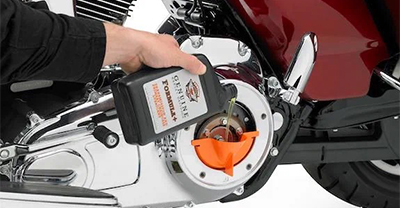
Changing your motorcycle's oil can seem daunting. But with the right tools, knowledge, and patience, you can easily do it yourself with this guide.
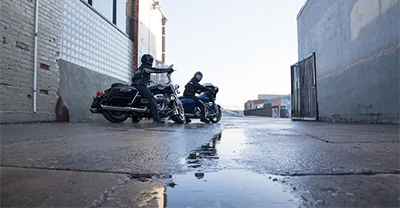
Being on the road when the weather turns wet is all about understanding the needed adjustments. These six wet weather tips will keep the fun going. Learn more!
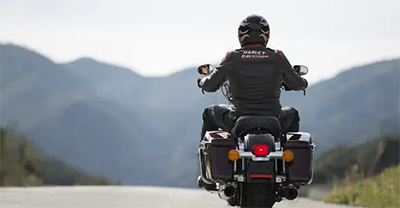
Dehydration and heatstroke are serious matters and can sneak up on you on long rides. It pays to know the warning signs and how to prevent them. Learn more!
The general information contained in this Blog is for informational or entertainment purposes only. The information in this Blog is provided “as is” and without any warranties of any kind. Neither Harley Davidson Insurance nor Sentry® or either entities’ affiliates and subsidiaries (Entity) accept any responsibility related to the content or accuracy of the information contained in this Blog. The information contained in this Blog should not be mistaken for professional or legal advice. Any use of this Blog or any third-party website linked to this Blog is at the risk of the user. No Entity is liable to any person or entity for any direct, indirect, or consequential damages arising out of the use or inability to use this Blog or any third-party website linked to this Blog. The views and opinions contained in third-party websites referenced in this Blog are the views and opinions of third-party authors and may not represent the opinions or policies of an Entity.

